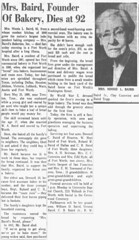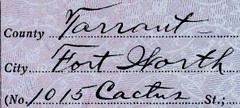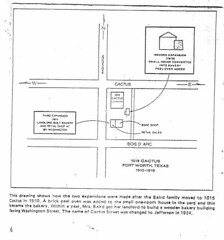The Mrs Baird's Story
They came to Texas in a chair car and brought Fort Worth its first steam popcorn machine. The story of the Baird family and the baking business they started.
In 1901 William Allen Baird, then a young man of 33, came to Texas to "look around" and see what kind of opportunities the Lone Star State might hold. Back in Tennessee he and wis wife Ninnie had operated a bakery and restaurant at Trenton and later a bakery at Covington. He liked what he saw in Fort Worth, decided to introduce the first steam popcorn machine in the city, and called his wife in Tennessee and told her to bring the family.
The family boarded the train for Texas in May, 1901. The steam popcorn machine had cost $425, so the family rode in the
chair car section. Mr. Baird and his wife Ninnie had four children then. They were Bess, 11; Dewey, 9; Hoyt, 4; and Roland, 1.
Arriving in Fort Worth, the family moved into rented quarters on East Belknap. Mr. Baird set up his steam popcorn machine at the corner of 7th and Main in downtown Fort Worth. Painted bright red and fitted with lots of brass, the popcorn machine had a clown and a steam whistle on top. It was quite an attraction. Eight months later, Mr. Baird bought a second machine and put it at 5th and Main. Dewey, the oldest son, operated this machine.
A restaurant on Exchange Avenue was put up for sale. Mr. Baird, who had operated restaurants in Tennessee, considered going back in the restaurant business. He decided this one was a good buy. It might also be good business, he reasoned, to buy "run down" restaurants, fix them up, operate them, and then sell them. So he sold his popcorn machines and bought the restaurant. In those days of slow transportation, you had to live near the place you worked. So the family moved to Rosen Heights.
Santa Fe Restaurant
In 1903, Mr. Baird sold the Exchange Avenue restaurant and began operating the Santa Fe Restaurant across from the Santa Fe Depot. It was here, Dewey Baird often recalled, that as a boy of 12 he stood on a box to help his father make nickel pies. Then he and his father hauled the pies 8 or 10 miles in a lunch wagon to the Swift and Armour packing houses on Fort Worth's North Side. The family lived next door to the restaurant. Later that year, Mr. Baird sold the Santa Fe Restaurant and began operating a bakery on Jennings Avenue. The family moved to Daggett Street. The old Fort Worth (Central) High School was on the next block where the Justin Boot Company is now located.
With Mr. Baird now operating a bakery, his wife could take a short rest from her own baking chores. Usually she baked all the bread for her family and did it very well indeed. She had often helped her husband with the baking back in Tennessee. But now one of the boys could bring bread home each day from the bakery.
Her "vacation" from baking did not last long. The Little Chicago Restaurant, between 10th and 11th Streets, was put up for sale. Mr. Baird sold the bakery and bought the Little Chicago. The family moved to West Broadway. At the Little Chicago in 1904 you could get a full meal for 15 cents. Dewey helped his dad at the restaurant.
512 Hemphill
In the early part of 1905, Mr. Baird sold the Little Chicago Restaurant and began operating a restaurant on 15th Street. Hoyt, who was now 8, picked up the meat for the restaurant early each morning at H. E. Sawyer Grocery on South Main and took it to the restaurant on his bicycle. He started the fire in the stove and made hot cake batter. When his father arrived to start serving breakfasts, Hoyt went on to school.
The family now lived at 512 Hemphill, on the corner of Hemphill and Cochran. Mrs. Baird was once more baking all the bread for her family. She often baked more than she needed and gave the extra loaves to her neighbors. They liked her bread and she soon gained quite a reputation around the neighborhood for baking good bread. In fact, her neighbors urged her to bake enough for them too whenever she baked. And even in those days they referred to her bread as "Mrs Baird's Bread."
Finally, in 1908, Mrs. Baird decided to take her neighbors' suggestion. She would bake bread to sell. Her husband was still operating the restaurant, but his health was not good. He suffered from diabetes, and this was long before the discoveries were made that would mean so much to people with this illness.
Mrs. Baird started baking in her small four-burner wood-fired kitchen range. At first the boys delivered the freshly baked bread on foot after school. They carried the loaves in baskets. The baskets had hinged tops, which raised at each end, much like modern picnic baskets. Mrs. Baird put a clean flour sack in the bottom, put in the loaves of still hot bread, and then covered them with another clean flour sack. Each basket held about 6 one-pound loaves of bread. Later the boys used a bicycle to make deliveries.

As more people wanted to buy her bread, Mrs. Baird remembered the small one-room house behind her rented home. It was unused. So she remodeled it and moved her baking there from the family kitchen. To bake more, she bought a commercial oven from the
Metropolitan Hotel. This oven baked 40 loaves at a time and was gas-fired. It burned the artificial "
Pintsch" gas then used in a number of homes and businesses. Walls of the oven were filled with sand to help keep the heat in. Mrs. Baird paid the hotel seventy-five dollars for the oven. She paid twenty-five dollars in cash and traded out the balance in bread and rolls. Dewey now helped his mother with the baking and the other boys delivered the bread. The girls helped by taking care of the housework so their mother could spend full time baking.
Sales Wagon
With more production, the delivery system now had trouble keeping up. Mr. Baird, who was a good mechanic, turned to the family buggy. It was a
Phaeton and, with a little modifying, might well solve the delivery problem. He took off the seats and built a wooden panel body. He put this on the buggy chassis. This made an excellent delivery wagon and greatly increased the little bakery's capacity for route service. The family owned two horses, Ned and Nellie, and they now joined the firm.
The sales wagon had three shelf areas. Merchandise was carried in large flat wire baskets with sides about 4 inches high. Clean flour sacks were first placed in the baskets. Then bread was placed on end in these baskets, 4 loaves wide, 6 loaves deep, for a total of 24 loaves in each basket. In those days, loaves were all one-pound size.
A Mr. Lipps was hired to drive the wagon. Whenever he was ill, 13-year-old Hoyt relieved him as driver. Later Hoyt became the regular driver.
A Mrs. Weston helped care for the younger children while Mrs. Baird worked in the bakery. Mrs. Weston had the first
phonograph the Baird children had ever seen. It was an Edison, with thick
cylinder-shaped records. "
The Preacher and the Bear" was one of the records that helped make the baby sitter's chore easier. The Baird family liked music. Mr. Baird played the harmonica, Dewey played the piano and mandolin, and all the family liked to sing along.
1015 Cactus
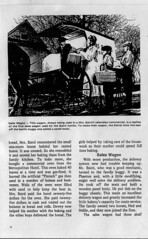
In 1910 the family moved again, this time to 1015 Cactus. The house was on the corner of Cactus and Washington. (Today Cactus is called Jefferson. The name was changed in 1924.) The lot was 50 feet wide and 150 feet deep. The family rented the house from a Mr. Hogg of Decatur. It also had a small one-room house in the back yard. Mr. Hogg agreed to remodel this. Mrs. Baird added a brick peel oven. The oven doors opened inside the building, but the bulk of the oven was outside.
The peel oven was heated by wood. First a fire was built in the firebox. Then, when the oven was hot, the fire was taken out and the bread put in to bake.
Wood was brought by the cord and came in long sticks about 2 inches in diameter. The Baird boys used a saw to cut the pieces to oven ... They put three or four sticks in ... at a time, then sawed them to proper length.
Young Hoyt was now the regular driver for the sales wagon. His mother would often go with him on the route. She helped get new customers while he was serving the regular customers, and she also checked her 14-year-old driver-salesman's ledger to be sure he was keeping it properly. This was a paperback notebook ledger which the driver carried on the wagon. It carried a record of sales to charge customers. These charge customers paid once a week. Customers could buy 24 tickets for a dollar. Each ticket was good for a one-pound loaf of bread. This brought in cash for the business.
Other than the notebook carried on the wagon, the family did not keep a set of books. If they had money left over at the end of the month, they figured they had made a profit.
William A. Baird, the father who had brought his family to Texas 10 years earlier, died on December 20, 1911. He died without dreaming that the little bakery his wife had started would one day become the nation's largest family-owned baking organization. But even then, in the last days of his illness, he must have gained great consolation from the knowledge that his family could support itself.
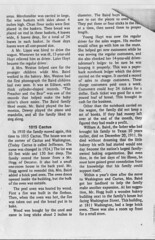
Within a year's time after the move to Washington and Cactus, Mrs. Baird got her landlord to help the family make another expansion. At her suggestion, Mr. Hogg built a wooden bakery building next to the family's house but facing Washington Street. This building at 1811 Washington, had a large brick oven. There was also a room up front for a retail store.
Each morning, Mrs. Baird and Dewey worked at baking bread and cakes. In the afternoon she hung up her apron, put on a clean dress, and worked in the store. Bess, the oldest daughter, worked downtown for E. E. Fosdick Insurance and Real Estate, doing her part to help support the family. She remembers seeing her mother, after a long day in the bakery, darning the boys socks by lamplight, dozing, and awakening with a start when she jabbed herself with the darning needle. So Bess began bringing home a a pair of socks on Saturdays for each of her brothers. "They wore them out so fast," she remembers.
The first Mrs. Baird's cakes were baked in this Washington Street bakery for sale in the retail store and on the wagon's sales route. Mrs. Baird now baked a complete line, from creme puffs to layer cakes, cinnamon rolls, and pies. Roland, now 12, was also helping his mother and Dewey with the baking.
In the bake shop, production was all done by hand. These hand operations were the same operations that are performed today by machines where bread is baked the yeast-rising way.
Mrs. Baird mixed dough by hand. She used a wooden trough (pronounced "troe") that was about 6 feet long, 24 inches wide, and 24 inches deep. The trough held about 300 pounds of dough. Mrs. Baird put flour and other ingredients into the trough, mixed these by hand, let it set and rise. When the dough had risen, she punched it down, let it rise again, and then punched it down again. Then she and her oldest son Dewey cut off sections of dough with a dough knife and put it on the work bench. Here the dough was cut to loaf size. Each time a piece of dough was cut, it was checked on a scale set at the weight desired (18 1/2 ounces.) It was seldom that Dewey or his mother had to do any additional cutting. Through long practice they knew the exact size needed.
The work bench had flour sifted on it. The steps in make-up went like this:
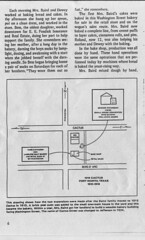
1. The first baker cut off loaf-sized pieces of dough.
2. The second baker, with flour dust on hands and handling two pieces of dough at a time, rolled the loaf-sized piece into balls. (He was performing the operation done today by the rounder.)
3. These rounded pieces of dough were then placed in the lines at the end of the work table. They were allowed to to proof there. (Relax and rise.) Flour sacks were laid over these rounded pieces of dough to keep them from drying out.
4. When the dough was ready, the baker pressed each dough piece with the palm of his hand, mashing it flat. Next he stretched it, then folded one side over the other, rolling the dough up like a jelly roll with the ends open. (The tigh ... dough was rolled, the bett ... the finished loaf would be. Today this is done by the molder.)
5. Then the rolled dough pieces were placed in pans.
6. The pans were next placed on wire racks and rolled into the proof box to rise. In the proof box, the dough had to remain moist while rising or a crust would form. At first, the Bairds placed pans of hot water in the bottom of the proof box. Later they added a steam pipe.
7. When the dough had risen to fill the pans, the racks were rolled out of the proof box to the front of the oven. Then, using a long-handled
peel, the pans of dough were placed into the pre-heated oven to bake.
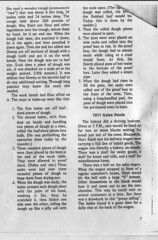 1911 Sales Route
1911 Sales RouteThe bakery did a thriving business. Often at 5 P.M., cars would be lined up for two or more blocks waiting for bread just out of the oven. Meanwhile, Hoyt Baird and his delivery wagon were carrying a full line of baked goods. The wagon was literally a bakery on wheels. There was a shelf for sweet goods, a shelf for bread and rolls, and a shelf for miscellaneous items.
There was a bell on the sales wagon. When the wagon stopped in front of a regular customer's house, Hoyt would hit the bell with a large "S" wrench. Other housewives in the block would hear it and come out to see the merchandise. This way he could wait on several customers at a time. But there was a drawback to this "group selling". The ladies found it a great time for a daily chat at the back of the wagon.
While they were chatting and deciding what they wanted to buy, the horse would most likely be sampling a customer's lawn. "Sampling" meant grabbing a mouthful of grass and pulling it out by the roots. If the conversation at the back of the wagon lasted too long, Ned the horse might step up on the lawn with both front feet for a better go at the grass. Lawn owners didn't like this. A housewife, at the back of the wagon, would suddenly yell, "Get that horse of my lawn!"
When a group of customers had been served, the driver would quickly close the wagon's rear doors. The moment Ned heard the doors close, he took off. He was on his way to the next customer, and some greener grass in the next block. Ned knew all the stops. He would stride down the street and, when he came to a customer's house, wouild stop abruptly. There were times when Hoyt would be off the route for a day or two. When he returned, Ned might suddenly stop in front of a strange house. Sometimes it took a lot of urging to get Ned to move on. Later, Hoyt would learn the house was a new stop added while he was gone.
As Hoyt drove his wagon along the sales route, he often saw Bruno Reich, who operated a wholesale bakery route, serving stores with a truck. He could not help envying Bruno and longed for the day when he could have a truck for his route. That day came sooner than he expected.
In 1917, the family bought a Ford car. They had a panel body built for it, took off the passenger seats, and bolted the panel body in place to make a panel truck. The truck was painted a cream color and "Eat More Mrs. Baird's Bread" was lettered on each side. About this time the Bairds took on three wholesale accounts. These were the Telephone Exchange at Rosedale and Jennings, which bought only pies; the Telephone Exchange at Lamar and 10th, which also bought pies; and the Sandegard Grocery at 10th and Houston.
Sandegard's was a large store that also had a delicatessen. The delicatessen served sandwiches and lunches. At first the store took only cakes, and built a special case for these. The store was served daily, with delivery twice on Saturday. Later bread was added. It was displayed on top of the cake display case. People would often stop Hoyt when he came in with a basket of bread and take the freshly baked loaves out of the basket before he could put it on top of the display case. No one back at the little bakery realized, as the first grocery store was added to the sales route, that this was a most significant event. For it was with the grocer and his customers, not house to house, that the organization's future would lie.
Wholesale Begins
In September of 1918, Hoyt entered the army and the sales route had no driver. The family decided to discontinue the retail route and go wholesale. Dewey hired the bakery's iceman, Charlie Longguth, to operate the new wholesale route. Longguth was to remain the bakery's No. 1 route salesman for many years. (He retired in 1951.)
By this time Sandegard's had 15 or more small stores and had become a sizable local chain. Apparently Manager Harry Adams had been impressed with the way folks in his first store liked Mrs. Baird's Bread. He put Mrs. Baird's Bread in all Sandegard stores. This took amost all the bread the little Washington Street bakery could bake. But not for long.
In early 1919, the family bought a lot at Sixth Avenue and Terrell from a Mr. Casey, who operated a drug store across the street. They built a brick building on the lot. It was the first bakery they had built themselves and they were justly proud of it. The building was 30 feet wide and 72 feet long. The family installed a Peterson Peel gas-fired oven. The oven had a capacity of 400 one-pound loaves. They also purchased a hand wrapping machine.
Total investment for the 6th Avenue and Terrell bakery was $8,800.00. The oven cost about $3,500.00. It was purchased on credit from the Peterson Oven Company.
In June 1919, the bakery began operating in the new building. The business continued to grow. The family bought a second truck, also a Ford, and put on a second sales route.
Shorty after, two routes increased to four, and Fort Worth distribution looked like this:
Route No. 1 - Charlie Longguth, serving the South side.
Route No. 2 - Ben Dollins, who operated the downtown restaurant route.
Route No. 3 - Howard Townsend, whose route reached from Rail Road Avenue to Magnolia on the South side.
Route No. 4 - Arlie Whitley, who served the North side.
These four routes covered all of Fort Worth except for the East side. Route No. 5 was later added to serve the East side, which included Polytechnic area. Claude Leath was hired as salesman for this new route.
From 1919 to 1928, the new bakery was enlarged nine times. This was one addition each year. Competitors in the Fort Worth market were Reich's B & B (Biggest and Best), Walker's Big Dandy Bread, and Doherty's Butter Krust.
About 1920, the family induced Mrs. Baird to quit working in the bakery. They thought she had worked long enough. The family built a two-story home on the corner of Scott and Beach Streets. Mrs. Baird moved there and quit working in the retail sales room. Later she moved to 2429 Rogers Road. She continued as active head of the business until her death in 1961.
With the bakery at 6th Avenue and Terrell doing well, Roland suggested expanding to Dallas. Mrs. Baird could have said, "Let's just stay the size we are." The business could really be hurt if the expansion failed. "But she never batted an eye," Hoyt Baird recalls. She gave her approval for that expansion to Dallas and for the others that followed.
This willingness to take on new challenges was, he feels, the most important single factor in the growth and success of the business. It was this readiness to move ahead that helped to eventually create more than 2,500 jobs and make Mrs. Baird's the outstanding organization it is today.
As the Dallas plant was being planned, the family adopted a concept that would prove wise in the years ahead. A member of the Baird family would head the new plant for the family. He would represent the family, supervise each day's bake, and assume personal responsibility for the quality and freshness of the products that would bear the family's name. This concept of family supervision was a logical development. Since the very beginning, Mrs. Baird and her family had been closely involved in business. When they did all the baking and delivery, they had guarded quality and freshness as though their very future depended on it - and it did. When they hired people to help them with the baking and delivery, the family continued to be closely involved and personally responsible for the products they baked. In their growth, family supervision had been a way of life. Now, as they contemplated new frontiers, it would continue to be.
The Dallas plant opened in 1928, with son Roland Baird heading up the plant for the Baird family. In 1938, a plant was opened in Houston with Dewey heading the plant for the family and B.J. Barr as General Manager. Later Mr. Barr became a Vice President and member of the Board of Directors. That same year the Fort Worth operation moved into a new bread plant on Summit. The plant at Sixth and Terrell was now devoted exclusively to cakes. Hoyt Baird now headed the Fort Worth bread plant for the Baird family, with A. D. Gillespie, Sr. as General Manager. C. B. Baird headed the Cake plant with Dudley Johnson as General Manager.
During these years of growth for Mrs. Baird's, changes were also taking place in the way the products they were baked were being marketed. In the early 20's, wrapping was introduced for bread. The first wrapping machines were semi-automatic, with the operator doing part of the folding. Sliced bread was introduced in 1927. In November 1936, Mrs. Baird's began hand-twisting bread. This procedure, in which two half-loaf pieces of dough were intertwined to form one dough piece, continues today at all Mrs. Baird's plants. Twisting improves flavor, texture, and keeping qualities of the loaf.
In 1949, a new plant was built in Abilene. William D. (Bill) Baird headed the plant for the Baird family with A. D. Gillespie, Sr., as General Manager.
Plans were also underway to build a new plant in Dallas to match that growing market. In 1950, the continuous mix process was introduced to the baking industry. It offered a short cut in production time and a considerable saving in cost. The planners of the new Dallas plant carefully considered the revolutionary new process and decided to stay with the yeast-raised baking method they had used since the business began. They felt the consumer would prefer bread baked the yeast-raised way. They have never regretted the decision.
In 1953, Mrs. Baird's of Dallas moved into a huge new plant recognized by the industry as the nation's largest automatic bread plant.
Roland Baird, who helped his mother and older brother Dewey with baking and later headed the Dallas plant for the family, retired in 1954.
The business expanded again in 1959. Bakeries were purchased in Lubbock and Victoria and, early the next year, bakeries were also acquired in Austin and Waco. In 1969, a pie plant was purchased in Abilene.
But while the passing years brought growth, they also brought sadness. Mrs. Baird died June 3, 1961 after a long, eventful, and certainly gratifying life. She had often said she was far prouder that her children had grown up to be good citizens than she was of the fact that she had founded a successful business. At her funeral, the officiating minister described Mrs. Baird as "an ideal woman in the eyes of God." He said Mrs. Baird had fulfilled the highest traditions of American life but, in all the fullness of her work, she had always been a devoted mother and family woman. In Mrs. Baird's memory, the Texas Senate passed Senate Resolution No. 13. In the Resolution, the Senate said that Mrs. Baird has been "a living example for mothers, wives, business executives, Christians and good people the world over." Copies of the Resolution were sent to her family with deep regard of the Texas Senate.
Dewey Baird died March 25, 1965. Dewey was the oldest son and had been active in the business from the very beginning. He had been his mother's first assistant and, during the years, had gone on to become President and eventually Chairman of the Board.
C. B. Baird, Mrs. Baird's youngest son, died May 27, 1969. When the business started, C. B. had been only 5. But he soon took an active part in the young business, became an officer and member of the Board of Directors and, until his death, headed the Fort Worth Cake Plant for the Baird family.
Others who played vital roles in the growth of the business are also gone. Charlie Longguth, the iceman who became the Company's first route salesman, died in 1956. C. C. Gressett, who joined the company as a bookkeeper in 1924 and rose to Vice President and General Manager of the Dallas Plant, also a member of the Board of Directors, died in 1962. A. D. "Tiny" Gillespie, Sr., who joined the Company as a relief driver and later managed two bakeries, died in 1967. He had risen to Vice President and member of the Board of Directors. Dudley Johnson, who was the Cake Plant's first general manager and whose career spanned from route salesman to Vice President and member of the Board of Directors, died in late 1967.
B. J. Barr, who played a major role in establishing Mrs. Baird's products in the Houston market, died in 1975 after a long and colorful career in the baking industry. He joined Mrs. Baird's in 1938 and went to Houston as General Manager. He was later named Vice President and General Manager of the Houston plant. In 1957 he was named Executive Vice President. He retired in 1959 but continued as a member of the Board of Directors until his death.
Lillian Hughes started as a cashier in July, 1925 and during the ensuing years saw the organization grow from one plant to eleven. "All through the years," she said, "I learned one very important thing. Any employee who enjoys his or her work and does it well can expect advancement. The opportunity is there for everyone." When she retired on July 31, 1975 - the first employee to log 50 years of continuous service - Mrs. Hughes held the top level position of Corporate Secretary of Mrs Baird's Bakeries Inc.
William D. Baird, Chairman of the Board and grandson of the founder, died in 1976. When Bill was born the family business was housed in a two-room wooden building at 1811 Washington. He started working in the bakery as soon as his parents would let him, later supervised design and construction of bread plants at Fort Worth, Abilene, and Dallas, and for many years headed production for all Mrs. Baird's plants. There were and are many others in every area of the business, who have made lasting contributions to Mrs Baird's Bakeries.
In February 1970, Mrs. Baird's announced another expansion. Land was purchased for a new Cake Plant. The site was a 30-acre tract in South Fort Worth on Interstate 35, ideally suited for statewide distribution. Ground was broken September 28, 1970. The plant was completed in 1971 and production began early in 1972. The former Cake Plant at 6th Avenue and Terrell was closed in September, 1972, and all production moved to the new Cake Plant. In May, 1976, a bread plant was acquired in San Antonio, bring the total number of plants to 11.
As Mrs Baird's Bakeries moves toward the 80's, the same ingredients that brought the organization this far are still at work. It is still a family-owned business with W. Hoyt Baird as Chairman of the Executive Committee. Vernon Baird is President, Allen Baird is Executive Vice President, Clayton Baird is Senior Vice President, and Carroll Baird is Vice President of Operations. Three grandsons, Bob Baird, Bryon Baird, and Arthur Baird, and one great granson, Scott Baird, also hold top level positions. There is still the dedication and respect for baking a good product that Mrs. Baird instilled in her family at 512 Hemphill and 1811 Washington. The business that started in a home kitchen has grown until more than 2,500 families have joined the family that started it all. W. Hoyt Baird evaluates the contribution of this ever-growing team of employees this way: "There is no way this business could have succeeded without the cooperation and dedication of our employees. The secret of success in any business is people, and we have had - and still have - the very best!"
This, then, is the story of Mrs. Baird's until the present. But time does not stand still, and neither will this business. This Company's history has been a story of vitality, of teamwork, of growth, and of progress. Its future will be the same.
- end -
A
photo accompanies this document that shows a man driving a carriage with a line of three people next to it, apparently waiting to purchase bread. A section of a house is in the background. The caption reads:
Sales Wagon - This wagon, shown being used in a Mrs. Baird's television commercial, is a replica of the first sales wagon used by the Baird family. To make their wagon, the Bairds took the seat off the family buggy and added a panel body.
A diagram is also included with this document. It shows the location of the home on Cactus, along with the various bakery expansions at that location. More can be found on this in the
"Page 6" post.



